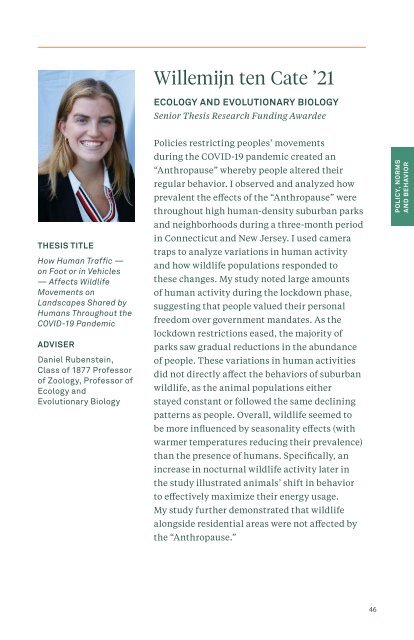Undergraduate Research: An Archive - 2021 Program
Create successful ePaper yourself
Turn your PDF publications into a flip-book with our unique Google optimized e-Paper software.
Willemijn ten Cate ’21<br />
ECOLOGY AND EVOLUTIONARY BIOLOGY<br />
Senior Thesis <strong>Research</strong> Funding Awardee<br />
THESIS TITLE<br />
How Human Traffic —<br />
on Foot or in Vehicles<br />
— Affects Wildlife<br />
Movements on<br />
Landscapes Shared by<br />
Humans Throughout the<br />
COVID-19 Pandemic<br />
ADVISER<br />
Daniel Rubenstein,<br />
Class of 1877 Professor<br />
of Zoology, Professor of<br />
Ecology and<br />
Evolutionary Biology<br />
Policies restricting peoples’ movements<br />
during the COVID-19 pandemic created an<br />
“<strong>An</strong>thropause” whereby people altered their<br />
regular behavior. I observed and analyzed how<br />
prevalent the effects of the “<strong>An</strong>thropause” were<br />
throughout high human-density suburban parks<br />
and neighborhoods during a three-month period<br />
in Connecticut and New Jersey. I used camera<br />
traps to analyze variations in human activity<br />
and how wildlife populations responded to<br />
these changes. My study noted large amounts<br />
of human activity during the lockdown phase,<br />
suggesting that people valued their personal<br />
freedom over government mandates. As the<br />
lockdown restrictions eased, the majority of<br />
parks saw gradual reductions in the abundance<br />
of people. These variations in human activities<br />
did not directly affect the behaviors of suburban<br />
wildlife, as the animal populations either<br />
stayed constant or followed the same declining<br />
patterns as people. Overall, wildlife seemed to<br />
be more influenced by seasonality effects (with<br />
warmer temperatures reducing their prevalence)<br />
than the presence of humans. Specifically, an<br />
increase in nocturnal wildlife activity later in<br />
the study illustrated animals’ shift in behavior<br />
to effectively maximize their energy usage.<br />
My study further demonstrated that wildlife<br />
alongside residential areas were not affected by<br />
the “<strong>An</strong>thropause.”<br />
POLICY, NORMS<br />
AND BEHAVIOR<br />
46

















